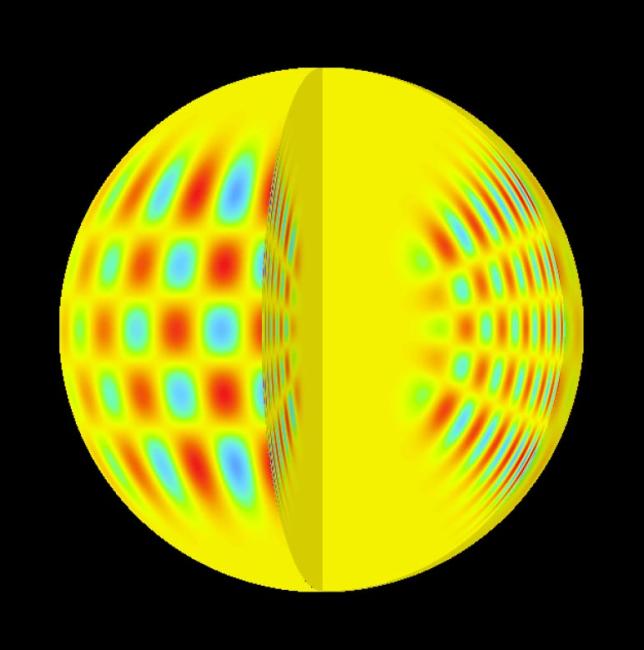
An illustration of vibration modes in the Sun. Astronomers have used the TESS mission to study for the first time stellar oscillations in intermeidate mass stars.
The interiors of stars are largely mysterious regions because they are so difficult to observe. Our lack of understanding about the physical processes there, like rotation and the mixing of hot gas, introduces considerable ambuguity about how stars shine and how they evolve. Stellar oscillations, detected through brightness fluctuations, offer one way to probe these subsurface regions. In the Sun, these vibrations are due to pressure waves generated by turbulence in its outer layers (the layers dominated by convective gas motions). Helioseismology is the name given to the study of these oscillations in the Sun, and asteroseismology is the term used for the same study in other stars.
Astronomers have long detected strong brightness variations in other stars, for example the class of Cepheid variable stars used to calibrate the cosmic distance scale, but the small, solar-like oscillations driven by convection near the star’s surface are much harder to see. Over the past few decades, space telescopes have successfully applied astroseismology to solar-type stars spanning many stages of stellar life. CfA astronomer Dave Latham was a member of a large team of astronomers who used the new TESS (Transiting Exoplanet Survey Satellite) datasets to study the interiors of the class of intermediate mass stars known as δ Sct and γ Dor stars. These stars are more massive than the Sun but not large enough to burn through their hydrogen fuel very rapidly and die as supernovae. Pulsations generally arise principally from one of two processes, those dominated by pressure (where the gas pressure restores perturbations) or by gravity (where buoyancy does). In these intermediate-mass stars both of these processes can be important, with pulsations having typical periods of roughly about six hours. The complexity of the combined processes, among other things, results in these intermediate-mass stars coming in a veritable zoo of variability types, and this variety offers astronomers more ways to test models of stellar interiors.
The astronomers analyzed TESS data on 117 of these stars using observations taken every two minutes; accurate distances to the stars (and hence accurate luminosities) were obtained from Gaia satellite measurements. The team was able for the first time to fully test and successfully refine models of pulsation for these stars. They found, for example, that gas mixing in the outer envelope plays an important role. They also spotted many higher-frequency pulsators, thereby identifying promising targets for future studies. Not least, they showed that the TESS mission has enormous potential not just for studying exoplanets, but also for improving our understanding the interiors of intermediate mass stars.
"The First View of δ Scuti and γ Doradus Stars with the TESS Mission," V. Antoci et al., MNRAS 490, 4040, 2019.